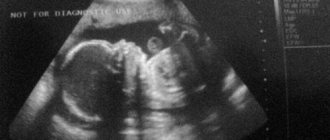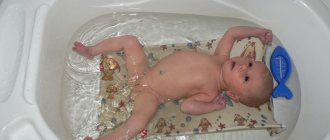How to safely pick up and put your baby back
To lift a lying child from a bed or other surface, you should, if possible, turn him on his back and, in this position, begin to pick him up. The most convenient and safest way is to place one or two hands under the baby’s head, neck, spine and butt and begin to lift. From this position it is already possible to shift the newborn from one position to another. The whole process should be calm and without sudden movements.
It is important to remember that until the baby holds his head (usually this lasts up to 3-4 months) and his abdominal and back muscles have not become stronger, you should always support his head and spine.
Under no circumstances should you simply pick up a newborn by the hands, as this may cause dislocation or damage to the ligaments.
To put the baby, for example, back in the crib or on the changing table, you should do it just as carefully and slowly, holding his head and butt. To prevent the child from falling out of his arms and feeling sudden movements, parents should bend over with their whole body to safely lower the baby. When the newborn comes into contact with a horizontal surface, you can slowly remove your hands from under his body.
Developmental activities
Today this phrase has been replicated, fashionable, and relevant.
But all the simplest games, communication, explanations and tactile contact - all this can be called developmental.
- massage and gymnastics . Can be used separately or together. It is useful to do a massage after waking up and before bathing. Gymnastics consists of passive movements (flexion, extension) of the baby’s limbs, turning over and stimulating crawling by pressing your fingers on the baby’s heels. Fitball also goes well with this process. The set of classes with it is simple, and information is easy to find on the Internet;
- maximum tactile contact . It is vital for the baby. Carry the baby in your arms, in a sling, breastfeed, do a light stroking massage;
- toys . The toy park for a 4-month-old child is much wider than, for example, for a one-month-old child. Teethers are added to the rattles, because the baby really wants to put everything in his mouth and gnaw on his itchy gums. It will be interesting for the baby to try fabric bags of different textures filled with buckwheat, semolina, peas, and small balls. The developmental mat becomes a whole storehouse of sensations. There are colors, fabrics with different tactile sensations, toys hanging above your head that you must definitely grab, a mirror that is very interesting to look at and recognize yourself;
- speech communication . Children are great imitators. The more often they hear the sounds of speech, the easier it will be for them to master it;
- joke poems, nursery rhymes . Familiar to everyone from childhood, “Magpie-Crow”, “Horned Goat”, “Ladushki” and others. The child also likes rhythmic sounds, accompanied by action - bathing, finger gymnastics, dressing, tickling, stroking;
- "Ku-ku" . At first glance, it’s a simple game to entertain a baby. In fact, through the play action, the child understands that the parent, when he leaves his field of vision, then definitely returns. On this basis, the baby develops trust in the world.
How to properly hold a newborn in your arms: popular poses
There are several positions in which you can comfortably and safely hold a small child. The choice of each of them depends only on what the parents intend to do.
Cradle
This pose can be used both with babies from the first days of their life, and with older children. In this position, parents hold the newborn’s butt and back with one hand, and place his head on the elbow of their other hand.
The position is suitable for rocking, feeding and even walking around the house or outside. You can take it standing or sitting.
When choosing this position, you need to make sure that the child does not stay in it for more than 5-10 minutes on one arm: if the newborn looks in one direction for a long time, this can lead to torticollis and improper formation of the spinal column. Therefore, you should constantly alternate hands: carry the baby either on your right or on your left hand.
Column
This position is also universal: for infants 0+ and older children.
To hold the child in this position, the parent needs to place his chin on his shoulder with one hand, while holding the head, and with the other to hold the entire spine area. If you want to turn the baby’s face away from you, then you should put the baby’s head on your shoulder and support his chest and stomach with both hands.
This position can be used while walking, rocking a newborn, or after feeding to allow him to burp excess air.
To make the position as safe as possible, it is worth considering one nuance: it is important that the child hangs slightly on one arm of mom or dad. It happens that parents make the mistake of fully placing the baby’s bottom on their arm. Since the newborn’s spine is still weak, and the muscle corset cannot yet hold it, such a load can harm the baby, so a baby should not sit down even in this way at an early age.
Face to face
This position is most convenient in the first months of a child’s life.
In this position, mom or dad are in a standing position. They should hold the baby's head, neck and back with one hand, and his butt with the other. At this time, the baby is positioned horizontally, with his stomach up. That is, the child seems to be suspended all the time.
In this position, it is ideal to establish contact with your child: tell him something and say words of love. And the newborn, in turn, will be able to see the parents’ faces even better in this position.
On the knees
The position is similar to the “face to face” pose, but with the exception of several points: firstly, parents take it while sitting, and secondly, you can only hold the baby’s head and neck with your hand, and his body - back and butt - are located in it's time on mom or dad's lap.
It is important that parents sit firmly and safely while doing this. For convenience, you can slightly raise your knees up.
In this position, you can communicate with the newborn, give him your smile, or even play.
On the stomach
This position can be taken from the age of two weeks when the baby is suffering from colic and gas formation. To do this, the child needs to be placed horizontally with his stomach down on the half-bent arm of the parent: so that his chin is next to the bend of the parent’s arm. With the other hand, mom or dad should support the newborn’s tummy.
In this position, the child can be carried around the house or walked with him on the street. Often mothers lay the baby out like this after feeding so that he burps up excess air.
On the hip
This position is acceptable for children from 6–7 months, when they can sit independently.
To take this position, the baby needs to spread his legs wide and, supporting his back and butt with one hand, sit him on your thigh. You don’t even have to use your other hand, but sometimes it’s still worth insuring your child with it.
The position allows parents to do many household chores or go for a walk with their child.
High chair
The position is suitable for newborns over 6 months of age who are already holding their head up and sitting up without any assistance.
We support the child’s body with one hand, and sit the baby on the other hand: so that his back and the back of his head rest on the parent’s stomach or chest.
The pose is suitable for indoor and outdoor walks. Kids especially like it because there is open space in front of them, which they are always happy to explore.
Psycho-emotional development
- The “revival complex” is easily caused. When he sees his parents or other familiar people, a 4-month-old baby smiles, rejoices, actively moves his arms and legs, and gurgles.
- Recognizes mother, distinguishes her from the rest.
- Smiles at his reflection.
- Babbles. At times you can hear not only individual sounds, but also the syllables “ma”, “pa”, “ba”. This is still an unconscious onomatopoeia, the progenitor of future active speech.
- Expresses various emotions. It's not just joy and sadness anymore. Anger, resentment, and fear are added.
- Behavior also becomes more differentiated. If the baby likes the game, he is happy. When it stops she starts crying. Among the toys, he singles out his favorite ones, which he is ready to play with all the time.
- Easily identifies the source of sound by turning his head towards it. The child begins to perceive music. Reacts well to rhythmic or melodic song.
- Concentrates, listens at the sound of his name.
- He begins to feel his body in space and gets acquainted with it. It's funny to watch a baby stare at his hands or feel his feet. This is how children are - learning through play.
- A baby's vision is almost at the level of an adult. The baby can already distinguish several colors - red, yellow and blue.
How to take a child for a bath
No matter how many months the newborn is, it is worth taking into account his gender during this hygienic event. Girls are placed with their stomachs up, and boys, on the contrary, are placed down. But many experts are confident that boys can be washed on either side: the genitals will not be harmed in any way. The choice is up to the parents.
And, according to some doctors, the age of the baby is important. If we are talking about newborns who do not know how to hold their head up, then they need to be washed in a face-up position: the baby’s body - neck, back, butt - is placed horizontally on the forearm, and its head at this time is located just above the bend of the arm. With the second hand we already carry out the water procedure.
When the baby is 6-7 months old and sits confidently, you can wash the grown child in the “potty seating” position, when his back fits tightly to the chest and stomach of his parents, and his legs in the knee bend at this time are thrown over the parent’s hand.
Miraculous physical contact
Carrying a child in your arms contributes to the development of his tactile sensitivity (sense of touch, touch). For a baby, these feelings are perhaps the most important. This is evidenced, for example, by the early intrauterine (at 5-6 weeks of pregnancy) formation of tactile receptors (nerve cells that transmit information about touch and touch to the brain), the advanced development of all other sense organs. Tactile receptors are not concentrated in one organ, like the eye or ear, but are scattered throughout the body, especially on the tips of the fingers and lips, and least of all on the shoulders, hips and back. There are several types and types of such nerve cells. Some quickly transmit touch information to the brain and switch off (for example, we quickly stop feeling the pressure of a watch strap on our hand), others work more slowly, but send signals to the brain for a long time, where they are processed.
At the same time, your actions should begin with one thing - go up to the child and take him in your arms to change clothes, feed him, rock him to sleep, sing a lullaby (in this case, it doesn’t matter to the baby whether you have an ear for music), etc.. Snuggled up to the mother, the baby calms down, warms up, does not waste time and energy on screaming and crying, but begins to look closely and listen to everything that is happening around.
Besides,
* Carrying in your arms trains the vestibular apparatus (especially if the mother periodically walks in a circle, for example, around a table, while simultaneously making smooth movements from side to side, up and down and back and forth).
* By observing the mother’s articulation and listening to her, the child prepares for independent speech development.
* The baby can pick up the intonations of a voice familiar from the prenatal period and adopt the emotional state of the mother.
* A young mother's anxiety decreases and her mood improves (which is especially important for depression, which is observed in some women after childbirth).
* Practical experience clearly demonstrates that premature babies quickly catch up with their peers in development if they grow up constantly in close proximity to their mother - in her arms: even her breathing helps stabilize the baby’s respiratory rhythm.
How to comfortably hold a baby while bathing
To lower your baby into the tub or tub, you need to place your hand behind his back and shoulders and hold his bottom with the other. When the baby is already in the water, you can remove your second hand and wash the baby with it, and with the other try, in addition to the upper part of the body, to also hold the lower part.
The main thing is that the newborn’s head and chin are above the water during such procedures. All this should be done calmly and carefully.
What does our restraint mean?
Rigid parenting methods, according to which holding a child in your arms means pampering him, ignore the baby’s natural need for the constant presence of the mother (or the one who is caring for him). Promoting the principle of early formation of “independence”, they have significant negative features.
Firstly, a child who is deliberately separated from his mother does not develop a trusting, kind attitude towards the world, and this will certainly have a negative impact in his adult life.
Secondly, limiting physical contact between mother and baby does not contribute to the emergence of mutual feelings between them. It is not surprising that in such cases the child is perceived as an obstacle to the usual way of life and ordinary activities. And the baby constantly needs communication and his crying is a call to everyone, and first of all to his mother: “I’m hungry!”, “I have a dirty diaper!”, “It’s hard for me to sleep!”. After all, even in cases where there seems to be no reason for tears, the baby may burst into offended or angry crying - because he is not yet ready for loneliness, his biological connection with his mother is still too strong.
Thirdly, it should be borne in mind that a strict attitude towards a child, when adults try not to show their feelings and emotions towards the child, is not the key to good upbringing of the child and his future success.
Of course, most often a young mother has a lot of troubles around the house. Therefore, if she often takes the baby in her arms, she will have to sacrifice some things. In addition, carrying a child in your arms is also physically not very easy. In general, if you wish, you can find many reasons to reduce physical contact with your child to a minimum. Here you need to set priorities and decide what is more important for you - the daily routine or the development of the child. If you want to properly take care of your child and at the same time not neglect your life, look for assistant allies with whom you can manage everything.











